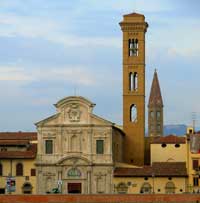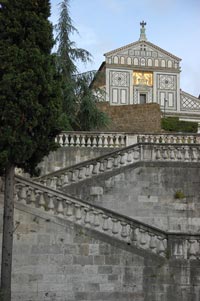| |
|
| |
|
|
|
|
|
|
| |
 |
|
 |
 |
| |
|
|
|
| |
|
Last supper frescoes in Florence | Itinerary along some of Florence's most exceptional examples of this famous scene.
|
|
|
|
| |
|
The refectories frescoed with the Last Supper are among the most interesting artistic monuments in Florence. No fewer than seven Last Supper frescoes exist within the confines of the ancient city center. From Santa Maria Novella on the northwest part of the city, to Ognissanti in the city center, to Santa Croce and San Salvi in the east, the collection of these incredible works span centuries, united by their subject matter.
The Last Supper scene was a truly Florentine tradition, found all over the city's monasteries from the 1300s to the late 1500s.
The image of the Last Supper was a common theme for refectories, especially in Florence. Besides the obvious connection to dining, the Last Supper often appeared within refectories to advocate meditation and prayer.
The cenacolo is a painting of the Last Supper decorating the refectories in convents and monasteries. Throughout the 14th century, the scene of the Last Supper was included in the grandiose cycles of frescoes which illustrated the Life and the Passion of Christ. During the 15th century, with invention of perspective, the Supper began to be represented independently on an entire wall.
Apart from the Cenacolo di San Salvi, all Florentine cenacoli follow the same pictorial scheme, featuring Jesus between Saint Peter and Saint John, whereas Judas Iscariot is set apart. In those of Ognissanti and San Marco we admire the bright, neat colours of Domenico Ghirlandaio, and in the former convent "di Fuligno" Perugino's triumph of light. The Last Supper painted in the convent of the Calza by Franciabigio clearly shows the influence of Leonardo da Vinci, while the grandiose fresco by Andrea del Sarto at San Salvi has the monumentality we associate with Michelangelo.
Domenico Ghirlandaio painted the scene of the Last Supper on several occasions within the space of a few years. Three works of his Last Supper still remain: in the abbey of Passignano sul Trasimeno, in the Ognissanti in Florence, and in the San Marco, Florence.
In the Basilica di Santa Maria Novella, you'll find Alessandro Allori's (the student of the great portrait painter Bronzino) Last Supper. Aside from the Last Supper and the frescoes of Paolo Uccello in the Green Cloister, you'll also find some stunning medieval frescoes in the Spanish chapel, accessed through the cloister.
The Last Supper by Pietro Perugino was painted in the early 1490s for the refectory of the Fuligno convent, used by a group of Fransiscan monks from Umbria.
In the refectory of Sant'Apollonia we find the dramatic, rigorously perspective version of Andrea del Castagno. Andrea del Castagno’s fresco along the north wall of the refectory, the Last Supper with the three Passion scenes of the Crucifixion, Entombment, and Resurrection above, was completed between July and early December of 1447.
In Santa Croce, the former refectory of the Franciscan convent is frescoed, beneath the great Tree of Life, with Taddeo Gaddi's 14th-century Last Supper.
Finally, in the antique monastery of Vallombrosiani annexed to the church of San Michele a San Salvi, the Museum of the Last Supper of Andrea del Sarto was built. Andrea Del Sarto's vivid portrayal of The Last Supper, painted between 1511 and 1527, is perhaps the most famous cenacolo (or Last Supper) in Florence. Housed in the old refectory of the Vallambrosan Abbey (now a museum), attached to the Church of San Michele a San Salvi, the fresco survived the great siege of Florence in 1530 only to suffer great damage from flooding in the 1960s'.
|
 |
Taddeo Gaddi, Cenacolo, Basilica di Santa Croce, Firenze. This is the oldest of all the Florentine Last Supper frescoes.
|
1. Chiesa di Ognissanti
Domenice Ghirlandaio, Last Supper fresco in the Church of Ognissanti
|
Ghirlandaio painted the scene of the Last Supper on several occasions within the space of a few years. In the Last Supper scenes of Ognissanti and San Marco we admire the bright, neat colours of Domenico Ghirlandaio. In 1480, Ghirlandaio painted the 'Saint Jerome in His Study' and other frescoes in the Church of Ognissanti, Florence, and a life-sized Last Supper in its refectory.
The earliest example of the Last Supper was painted in 1476 by Ghirlandaio in the abbey of San Michele Arcangelo a Passignano (in Tavernelle Val di Pesa), while the last surviving version of Ghirlandaio's Last Supper is in the refectory of the hostel of the San Marco convent.
|
The church of Ognissanti was part of the conventual complex founded in 1251 by the Umiliati, who had come to Florence from Lombardy in 1239.In the 15th century both Botticelli, who is buried in the church near his beloved Simonetta Vespucci, and Ghirlandaio worked at Ognissanti. Botticelli's fresco of Saint Augustine in his Study, balances Ghirlandaio's Saint Jerome in his Study in the chapel facing it across the navel, both executed in 1480. Perhaps the greatest of Ognissanti's frescoes is Ghirlandaio's Last Supper in the refectory. For the Vespucci, Ghirlandaio’s Last Supper (1480) and its sinopia were frescoed in the convent refectory, located between the first and second cloister of the old convent.Ghirlandaio produced with this fresco one of the best examples of his art, representing a serene yet dramatic episode of the Last Supper. The apostles are painted in the moment in which Jesus announces that one of them will betray him.
Art in Tuscany | Domenice Ghirlandaio, Last Supper frescoes
Address: Borgo Ognissanti, 42, 50123 Firenze
Opening hours: Monday, Wednesday, Saturday 9-12
|
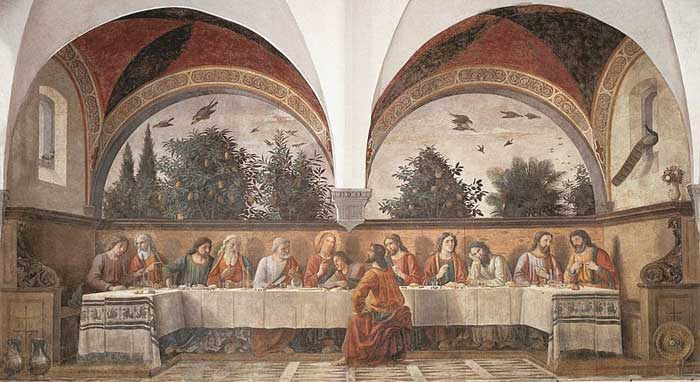
|
2. Museum of Santa Maria Novella
|
 |
Alessandro Allori, Last Supper, 1584, oil on canvas, old Refectory of the Convent, Basilica di Santa Maria Novella, Florence
|
Painted between 1584 and 1597, this dynamic Last Supper by Allori is found in the Basilica di Santa Maria Novella.
The panel in the lower center of the fresco is actually a canvas on which Allori has created a vision of an energetic and physically active Last Supper.
Alessandro Allori (1535-1607), Florentine painter, the pupil and adopted son of Bronzino. An early visit to Rome added the influence of late Michelangelo paintings to that of his master's courtly Mannerism. The Pearl Fishers (Studiolo of Francesco I, Palazzo Vecchio, Florence, c.1570) is generally considered his masterpiece; playful and full of artifice, it combines nude figures obviously drawn from Michelangelo with Bronzino's svelteness and enamelled colouring. He was one of the last notable exponents of Mannerism, painting in a style that had become outmoded by the time of his death.
Allori’s unique work served to inspire other artists of the late 16th Century to experiment with new styles of art. This is the final depiction of the Last Supper in a Florentine church.
Address: | Basilica of Santa Maria Novella, Piazza di Santa Maria Novella, 18, 50123 Florence
Opening hours : Monday, Thursday, Saturday, Sunday 10am-4pm
Weekday holidays 9am-2pm
|
|
|
|
3. Cenacolo di Fuligno Museum
|
 |
Pietro Perugino, The Last Supper, 1493-96, fresco, 440 x 800 cm, Convent of the Tertiary Franciscans, Foligno
|
The Cenacolo di Fuligno Museum is a tiny museum, well worth a visit. At first attributed to Raphael, the fresco is now generally believed to be the work of Perugino, though completed largely by his students.
Like many churches in Florence, the interior was whitewashed in the 18th century, and this beautiful Perugino fresco was uncovered and rediscovered only in the 19th century. In 1845 workers in an ex-convent uncovered an extraordinary site – a huge, intact fresco of the Last Supper in a former refectory. It was initially attributed to Raphael, who was actually Perugino's student. The idea has also been advanced that it was painted over another fresco of the same theme by Neri di Bicci (1419-1491).
The dining apostles are set against a sylvan country scene, creating the effect that you’re looking through a window onto the harmonious scene.
This work can be regarded as one of the most important examples of Umbrian culture of the Renaissance of which Perugino was one of the most serene and magnificent masters.
Address: Via Faenza, 40, 50123 Firenze
Admission Free
Opening hours: Blessed Angelina of Foligno | Tuesday, Thursday, Saturday 9-12
|
4. San Marco Museum | Domenico Ghirlandaio, Last Supper
|
The last surviving version of Ghirlandaio's Last Supper is in the refectory of the hostel of the San Marco convent.
The basic arrangement is the same as that in the fresco by Andrea del Castagno in the Florentine Cenacolo di Sant'Apollonia dating from about 1450.
|
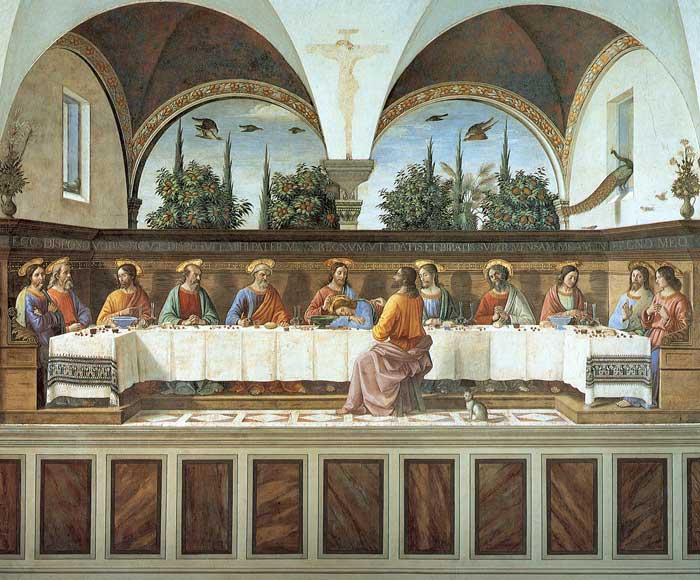 |
Ghirlandaio, Last Supper, c. 1486, fresco, 400 x 800 cm, San Marco, Florence
|
|
The disciples are sitting at a long table in front of a rear wall that runs parallel to the picture plan. Christ is sitting in the centre, and his favourite disciple John is leaning sadly against Him. To the right of Christ, in the place of honour, is the chief Apostle, Peter. Judas the traitor is the only one to be separated from the others: he is seated in front of the table.
The fresco showing "L'ultima Cena" (The Last Supper), recently restored, is located in an area close to the Foresteria (guest-quarters). This area was designed to host the most important guests in a separate hall from the Big Refectory, which was reserved for the friars.
Domenico Ghirlandaio was at the height of his popularity. He only prepared the design. The rest of the actual execution was carried out by his brother, David and by his pupil, Sebastiano Mainardi.
Address:
Opening hours
The Church of San Marco opens daily from 7 am to noon and from 4 pm to 8 pm.
The Museum of San Marco opens daily from 8:15 am to 13:50 pm.
On Saturday and Sunday it remains opened until 7 pm.
The Museum closes on the second and fourth Sunday and on the first, third and fifth Monday of the month.
Art in Tuscany | Ghirlandaio, Last Supper
Art in Tuscany | Fra Angelico | Frescoes in the Convento di San Marco (1438-50)
|
5. Cenacolo di sant'Apollonia
Andrea del Castagno, Last Supper, 1447
|
 |
Andrea del Castagno, Last Supper, 1447, fresco, Sant'Apollonia, Florence
|
In 1447 Andrea del Castagno worked in the refectory of Sant'Apollonia, painting, in the lower part, Last Supper fresco, accompanied by other scenes portraying the Deposition, Resurrection, and Crucifixion, which are now damaged. He also painted a lunette in the cloister, depicting a Pietà.
The detail and naturalism of del Castagno's Last Supper portray the ways in which del Castagno departed from earlier artistic styles. It is likely that Leonardo da Vinci was already familiar with this work before he painted his his own Last Supper in a more dramatic form to contrast with the stillness of these works, so that more emotion would be displayed.
Address: Saint Apollonia Last Supper, Via 27 Aprile, 1, 50129 Firenze
Opening hours : Monday – Sunday 8:15-1:50; closed 2nd, 4th Mondays and 1st, 3rd, 5th Sundays
|
|
|
|
6. Basilica of Santa Croce (Basilica of the Holy Cross)
|
 |
Taddeo Gaddi, Last Supper, Tree of Life and Four Miracle Scenes, 1360s, Fresco, 1120 x 1170 cm, Santa Croce, Florence
|
The Last Supper in Santa Croce church is the oldest of all the Florentine Last Supper frescoes. Painted by Taddeo Gaddi in 1340, it is the first Last Supper scene where you see Judas depicted on the opposite side of the table, a symbol of his betrayal and a way to spot him immediately in the group of apostles. This tradition of showing Judas this way is broken only by da Vinci in Milan and some 16th century versions.
Address: Piazza di Santa Croce, 16, 50122 Firenze
Opening hours
|
|
|
|
| |
|
|
|
|
Convento della Calza |
| |
|
In 1514, Franciabigio frescoed his Last Supper fresco for the Convento della Calza, done in the style of Andrea Mantegna (1431–1506). Franciabigio was a Florentine painter, a minor master of the High Renaissance style. He was a pupil of Marinotto Albertinelli and collaborated with Andrea del Sarto (on the frescoes in the Annunziata church in Florence), who was the dominant influence on his style, as may be seen in his frescoes of this Convent.
|
|
|
|
San Michele a San Salvi Church |
| |
|
The Andrea del Sarto Last Supper at San Salvi, a hidden jewel of a church on the outskirts of Florence, is about a 15-minute walk west from Santa Croce church.
San Salvi, also known as San Michele a San Salvi, was built in the 11th century by the Vallombrosans as part of an abbey complex. The refectory contains a masterwork fresco of the Last Supper (1519-1527) by Andrea del Sarto. His work represents one of the most spectaculalr examples of the subject, partially anticipating the baroque style in the strongly theatrical arrangement of the scene, which appears like a stage set.
An extensive restoration project ensues to preserve this work of art, which is still available to view as part of the museum.
Apart from the refectory where the cenacolo is, there's a long corridor and two other rooms full of altarpieces and fresco panels from other, usually demolished, churches, either by Andrea del Sarto or his contemporaries.
Address: Piazza di San Salvi, 10, 50135 Firenze
Opening hours : Andrea del Sarto | San Salvi | Tuesday – Sunday 8:15-1:50
|
|
|
|
|
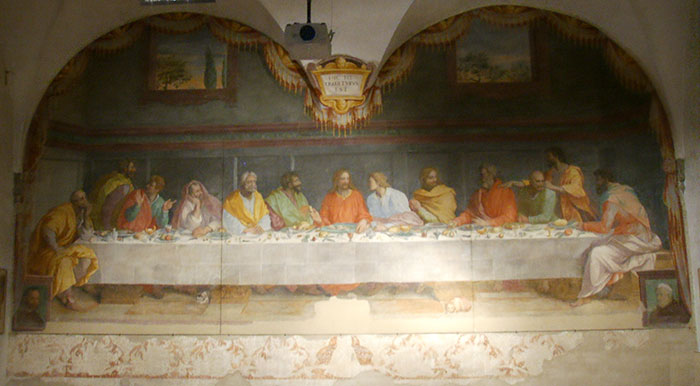 |
|
The church of Santa Maria del Carmine, originally built in romanic-gothic style, was almost completely rebuilt after a fire in 18th Century and is known for the frescoes in the Brancacci Chapel.
The church was almost completely destroyed in 1771, by the fire arosen during the construction of a new wooden ceiling; the Corsini and Brancacci Chapels, fortunately, were not destroyed, but the rest of the building went completely lost.
On the right side of the transept is the Brancacci Chapel, with frescoes by Masaccio, Masolino and Filippino Lippi. On the side of the Brancacci Chapel, in the Chapel della Passione are still visible some Fragments of frescoes dating to the 14th Century ascribed to Lippo Fiorentino; they depict the Last Supper and Saints.
Alessandro Allori, painted the Cenecola in Santa Maria del Carmine in 1582. It is clear in Santa Maria del Carmine that Da Vinci’s fresco heavily influenced Allori’s representation of the scene, painted about one-hundred years later than Ghirlandaio’s.
Alessandro Allori (1535-1607), Florentine painter, the pupil and adopted son of Bronzino.
His son Cristofano (1577-1621) was one of the leading Florentine painters of his period, working in a style that was more naturalistic and Baroque than that of his father. He is remembered primarily for one work, Judith with the Head of Holofernes (c. 1615, Palazzo Pitti), in which his femme fatale mistress is portrayed as Judith and he has depicted his own features in Holofernes' severed head.
Address: Santa Maria del Carmine, Piazza del Carmine, Florence
Opening hours : Alessandro Allori | Santa Maria del Carmine | Monday, Wednesday, Thursday, Friday 9-12; Tuesday and Saturday 10-12
|
|
|
|
Santo Spirito (Fondazione Salvatore Romano), Andrea Orcagna (1365)
|

|
Andrea Orcagna, Cenacolo, Santo Spirito (Fondazione Salvatore Romano) (1365) [3]
|
Next to the church of Santo Spirito in Florence, you can enter an ancient Augustinian dining hall called the refettorio or refectory. It is a large hall that is one of the oldest parts of the adjacent 14th-century monastery. It is home to the Fondazione Salvatore Romano.
But the biggest attraction of this extraordinary museum remains the mural by Andrea Orcagna. At the end of the 19th century, the cenacolo was still used as a tram depot. The entrance gate to this depot largely destroyed Andrea Orcagna's Last Supper. On the right, we can still see two of the apostles that have survived and, in a niche, a watching monk.
Andrea Orcagna | Santo Spirito | 9:30 – 12:30, 4-5:30; closed on Wednesday
Fondazione Salvatore Romano
055 287043
Piazza Santo Spirito 29
Website: Fondazione Romano
.
|
|
 |
|
 |
|
|
Andrea Orcagna, Crocifissione e ultima cena, Fondazione Salvatore Romano, Santo Spirito (1365)
|
|
Andrea Orcagna, Cenacolo, Santo Spirito (Fondazione Salvatore Romano)
|
|
Andrea Orcagna, Crocifissione e Ultima Cena (particolare, in una nicchia, un monaco che osserva la cena), 1360-65 ca.
|
| |
|
|
|
|
| |
|
Chronology
Cenacolo di Santa Croce, Museo dell'Opera di Santa Croce, piazza Santa Croce, piazza Santa Croce, Taddeo Gaddi's Last Supper (about 1340).
Cenacolo of Santo Spirito, Ancient Refectory of Santo Spirito, Museo della Fondazione Romano, piazza Santo Spirito, fragment of the Last Supper of Andrea di Cione, called Orcagna (about 1370).
Cenacolo of Sant'Apollonia, Museo del Cenacolo di Sant'Apollonia, via XVII Aprile n. 1, Andrea Del Castagno's Last Supper of (about 1450).
Cenacolo of Ognissanti, Cenacolo del Ghirlandaio, via Borgognissanti, 42, the Last Supper of Domenico Bigordi, called Ghirlandaio (about 1480).
Cenacolo of San Marco, refectory of the ex guest-room, 1, piazza San Marco, Ghirlandaio's Last Supper (about 1482).
Cenacolo of Fuligno, Museo dell'ex Conservatorio di Sant'Onofrio, or of Fuligno, via Faenza n. 42, Last Supper of Pietro Vannucci, called Perugino, and workshop (about 1495).
Cenacolo "della" Calza, Convento della Calza, piazza della Calza n. 6, Ultima Cena Last Supper of Francesco di Cristofano, called Franciabigio (1514).
Cenacolo of San Salvi, monastery of San Michele in San Salvi, museum of the cenacolo di San Salvi, 16, via di San Salvi, Andrea del Sarto's Last Supper (1527)

Paolo Morachiello, Fra Angelico: The San Marco Frescoes, Museo Di San Marco, Thames & Hudson, 1996.
Eva Maria Lundin, Andrea del Castagno's Last Supper | www.athenaeum.libs.uga.edu]

[1] Borsook, 87; Kate Lowe, “Nuns and choice,” 131.
[2] Creighton E. Gilbert, Last Suppers and Their Refectories, in The Pursuit of Holiness in Late Medieval and Renaissance Religion, Papers from The University of Michigan Conference, edited by Charles Trinkaus with Heiko.
A. Oberman (Leiden: E. J. Brill, 1974), 372-373 states that the relationship between a refectory and the image of the Last Supper is “supported not only by the frequency of Last Supper images in refectories and their infrequency everywhere else, but by other kinds of data, including writings giving directions about what art ought to do,” hence the idea of meditating and praying in front of a painting which served as a “mirror” – where the monks reflect the apostles, or vice versa. Warman Welliver, “Symbolic Meaning in Leonardo’s and Raphael’s Painted Architecture,” The Art Quarterly, Winter, 2 (1979), 50 reiterates the notion that a Last Supper painting in a refectory was intended to be an extension of the actual monks who sat in the same space, dining at similar table settings.
[From: Eva Maria Lundin, Andrea del Castagno's Last Supper | www.athenaeum.libs.uga.edu]
[3] Foto diTajchman, Opera propria, licenziato in base ai termini della licenza CC BY-SA 4.0, Collegamento
[4] Foto di Sailko, licenziato in base ai termini della licenza Creative Commons Attribuzione 3.0 Unported
|

One of Tuscany's best-kept secrets is the beautiful valley sheltering this recently renovated 18th-century
farmhouse, a podere retaining all the charm and delight of its past combined with updated comfort.
Podere Santa Pia is an authentic holiday home in Castiglioncello Bandini, a small village in the Maremma, in the south of Tuscany, situated halfway between Florence and Rome and close to Montalcino, Arcidosso, and Monte Amiata.
Podere Santa Pia, with its magnificent panoramic views of mountains and villages. .... a perfect way for groups or families on a budget to get a great vacation home deal.
Tuscan Holiday houses | Podere Santa Pia
|
|
|
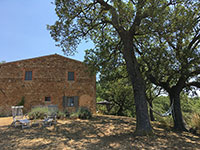 |
|

|
|
|
|
|
The vast and endless golden rolling hills of the Tuscan Maremma
|
Close to the house is a unique private swimming pool (12 x 5 m). On the spacious terrace around the pool are sun loungers, tables, chairs.... This is also an ideal place for outdoor dining, to enjoy an apero or dinner al fresco. The views are truly stunning, with a unique view of the hills of the Tuscan Maremma and the Tyrrhenian Sea in the background.
|
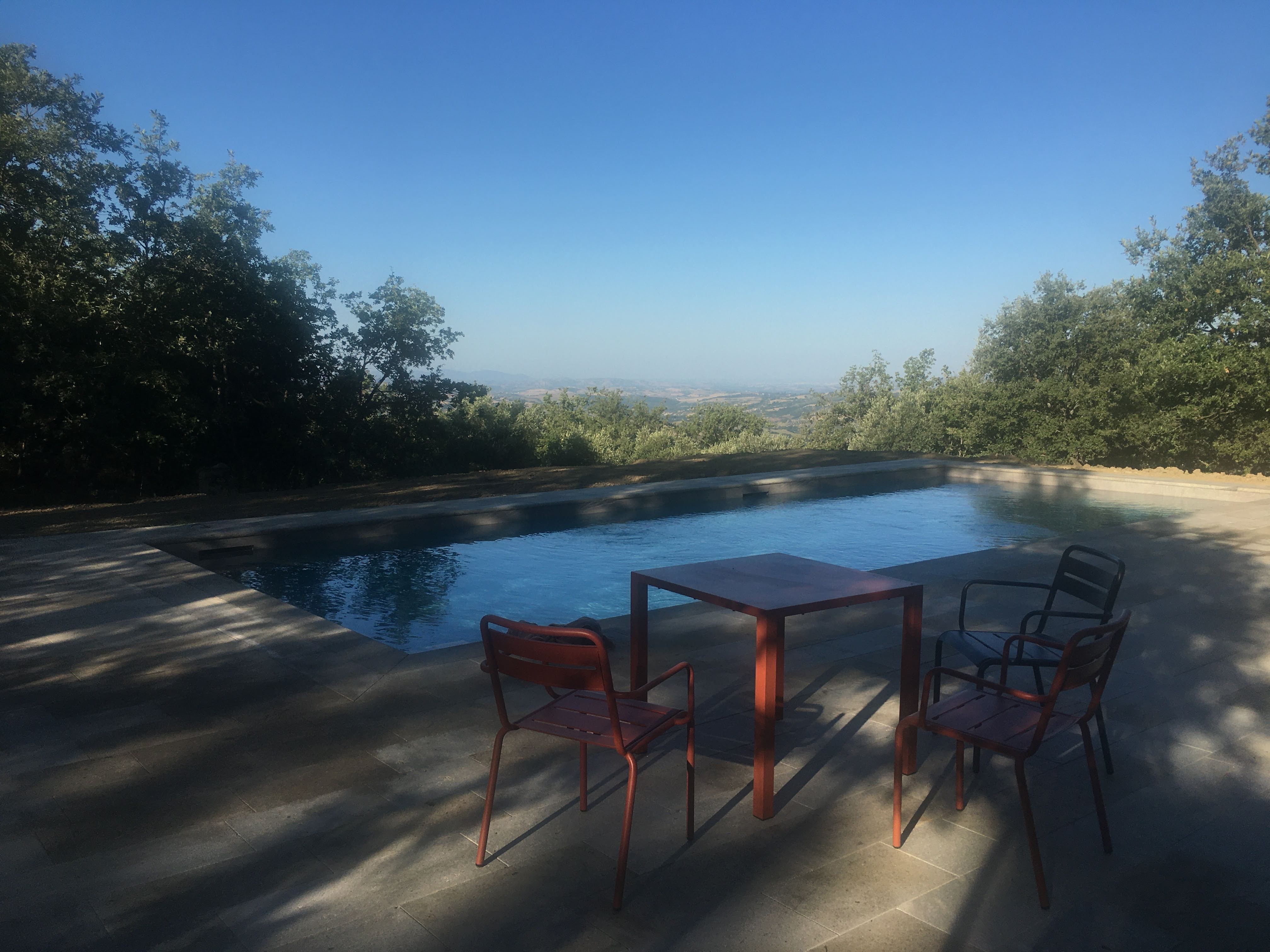 |
|
 |
|
 |
Early morning light at the private swimming pool at Podere Santa Pia
|
|
A bigger splash in swimming pool at Podere Santa Pia, southern Tuscany
|
|
A beautiful early evening by the pool, in the resplendent Tuscan sun, time takes on a languid quality
|
 |
Podere Santa Pia overlooks a valley characterised by all the elements of the Tuscan landscape: vineyards, pastures, small forests, wheat fields, olive groves and downey oaks. The view from the main terrace is definitely spectacular, on a clear day you can see as far as Corsica to the south.
|
| |
|
|
|
|
|
|
|
|
|
|
Podere Santa Pia |
|
Podere Santa Pia, garden |
|
Florence, Duomo |
| |
|
|
|
|
|
|
|
|
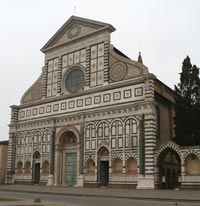
|
Ognidanti |
|
Santa Marina al Monte
|
|
|
| |
|
|
|
|
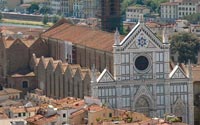 |
|
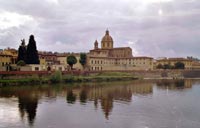 |
|
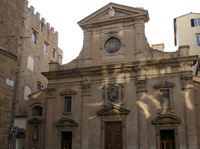 |
Certosa del Galluzzo (Firenze) |
|
Santa Maria del Carmine |
|
Santa Trinità |
|
|
|
|
|
|
|
| |
|
|
|
| |
|
|
|
| |
|
|
|
| |
|
|
|
| |
|
|
|
| |
|
|
|
![]()
![]()
![]()
![]()
![]()

















